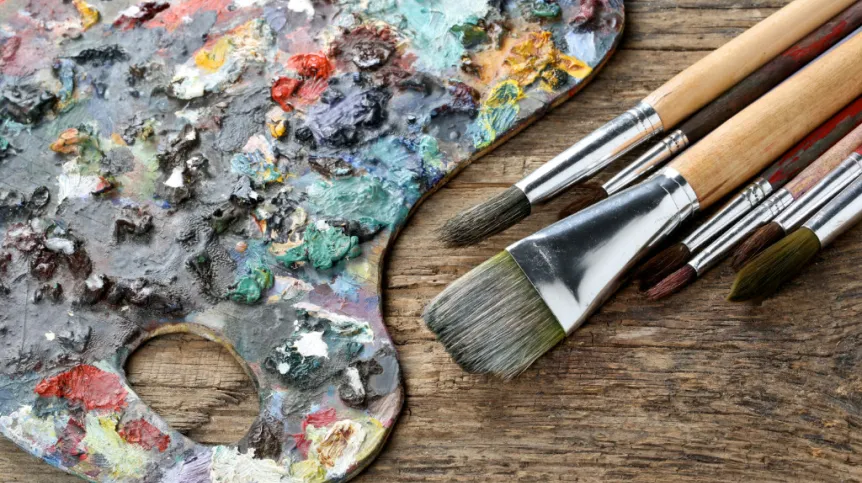
Unevenly aging pigments in the paintings, toxic solvents for cleaning works of art, moisture destroying old buildings - conservators face many challenges. To their aid come researchers from the AGH UST Academic Centre for Materials and Nanotechnology in Kraków, who are developing innovative nanomaterials.
The fact that a product has been used for hundreds of years does not mean it is the best. Many materials used in art conservation are far from perfect. Some of them are, for example, toxic or difficult to obtain. There are also substances that do not age well or are not sufficiently effective.
New nanomaterials give hope, as they can be designed to be in every way superior to conventional compounds used by conservators. Innovative nanoparticles for painting and conservation work are being developed by an interdisciplinary team from Kraków. Researchers are also working on nanoparticles for marking objects, which would make work of art impossible to forge.
LOOKING FOR PROBLEMS TO SOLVE THEM
In a project implemented under the program TANGO of the National Science Centre and the National Centre for Research and Development researchers will synthesize substances including nanoparticles and microemulsions conservation and marking oil paintings, ceramics and leather, and even architectural monuments. "For now, we are in intensive consultations with conservators and artists. We want to identify their most urgent needs. We will continue looking for ideas for new products until the end of the year, and then start developing nanomaterials, which will prove to be the most desirable" - said in an interview with PAP the project leader, Prof. Konrad Szaciłowski from the AGH UST Academic Centre for Materials and Nanotechnology in Kraków.
"Our research team is interdisciplinary, because the problem is extremely complex. It is not, after all, only about developing a new material, but also putting it into the structure of objects, which are of great historical value. This is a huge responsibility. Because of that, in our team we have not only chemists and physicists, but also conservators, who will test our materials on objects of art" - the researcher explained in an interview with PAP. He added that his team is in contact with museums and departments of art restoration at the Polish Academies of Fine Arts.
REPLACE THE IRREPLACEABLE
According to Prof. Szaciłowski, there is a number of problems; for example, museums report that they need to protect works of art from moisture, mice, fungus, corrosion. Some would like a substance for conservation of ancient weapons, others are looking for ideas for conservation of contemporary art created with custom techniques. The problems are many, but the time for the project is only two years.
The ream already has an idea how to help one of the Polish museums, which has a problem with impregnation of limestone walls. "This museum has to be closed for two days once every two months to impregnate the walls with protective solution" - said Szaciłowski. Meanwhile, researchers from his team know how to prepare a much more effective formulation that would protect the walls up to 6 times longer. "For a museum that would mean big savings. The walls would have to be impregnated only once every two years" - he said.
SAFE COMPOUNDS
Physicists and chemists also want to tackle the problem of consolidation - strengthening strongly weathered surfaces. Under the influence of factors such as moisture or temperature changes, oil paintings, ceramics and architectural monuments are subject to weathering processes, they crumble and break. Szaciłowski explained that conservators previously used synthetic resins for the consolidation of such objects. According to the researcher, there substances are not perfect - often they can not be removed and are chemically different from the original. In addition, in some cases they can actually accelerate the degradation of the material - because, for example, they have a different thermal expansion coefficient than the material which they penetrate, due to which the object may crack.
"Knowing the chemical composition of the object - for example ceramics - which we want to preserve - we can select the composition of nanoparticles that we will be close to the chemical composition of the original - said the researcher. - Our materials will not chemically alter the work of art". He explained that, for example, in the case ceramics researchers would use aluminosilicates or silicates, but with a different crystal structure than the original. They will age at the same rate as the original.
HEALTHY CLEANING
Another urgent issue is the problem of cleaning old objects - conservators have to remove the dirt that has accumulated for centuries, but without damaging the substrate. "Solvents used until now were almost always toxic and flammable. And in addition they has a terrible smell, which did not make the conservators\' work any easier" - said the researcher. Meanwhile, scientists believe that they can develop much less toxic microemulsions. Traditional solvents will be a few dozen percentage of their composition. "We will develop a cocktail, in which water or alcohol will be the carrier of the cleaning substance. As a result, the product will not only be effective, but also more friendly to humans and the environment" - revealed the researcher.
AGING BY ILLUMINATION
The researchers are also considering working on new dyes - ingredients of paints. "We want to know how these materials will change - for example after a few hundred years. In the test chamber so we can subject objects, such as painting created for the needs of the experiment, to aging at a rate of 50 years per day" - said Prof. Szaciłowski. He explained that this process involves illuminating the object with a powerful light source and observing, how the photodegradation of material progresses. "Works of art are affected by various factors, but we know from experience that light degrades works of art most seriously - it carries the most energy" - explained the researcher.
INVISIBLE SIGNATURE
The final element of the project is marking works of art. "We want to develop a kind of molecular bar code for works of art. It will be virtually indelible, unmistakeable and completely invisible to the viewer" - says the scientist from AGH. He admitted that such a chemical signature would help museums protect their collections - hinder trade in stolen works of art and help distinguish between original works and counterfeits. "This type of solution has already been used, for example, for marking explosives - that in case of their use in a terrorist attack their source could be identified " - he said. He added that in those solutions microcapsules with laser-printed manufacturer identifier are added to the product. "We have a different idea for adding such unique molecular stamps to works of art" - said Prof. Szaciłowski.
SO THAT SCIENCE FOR ART IS NOT ART FOR ART\'S SAKE
"We are physicists and chemists. We have extensive experience in developing new materials with desired properties. We know where to start and what to avoid. The problem is that the material should be compatible with the work of art, capable of properly penetrate it, and not destroy it. Hence the huge importance of consultation with artists and conservators. We are trying to translate their needs into the language of our laboratory procedures" - he said.
"When it comes to materials for artists, we have a lot of ideas. They include paints that change the characteristics depending on the lighting or the viewing angle, paints that glow in the dark, emit sounds... The possibilities are endless. We can work on this, if there is interest. But first we must examine the market. We do not want our science to be art for art\'s sake" - he concluded.
PAP - Science and Scholarship in Poland, Ludwika Tomala
lt/ agt/ mrt/
tr. RL













